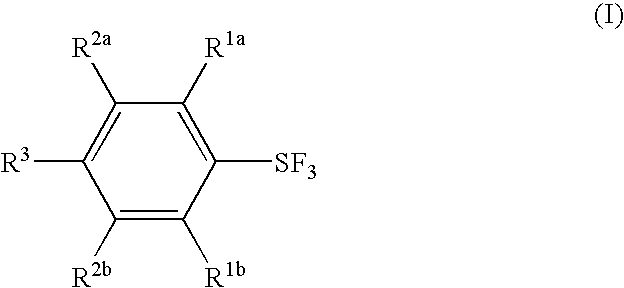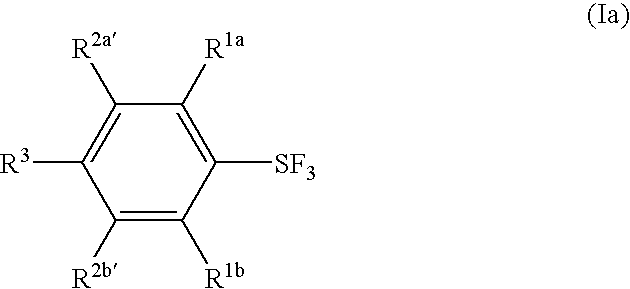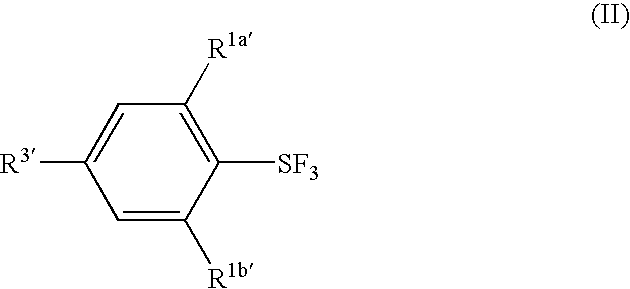Substituted phenylsulfur trifluoride and other like fluorinating agents
a technology of phenylsulfur trifluoride and substituted phenylsulfur, which is applied in the field of fluorinating agents, can solve the problems of high cost, low efficiency, and inability to meet the needs of the market, and achieve the effect of substantial functional and safety benefits
- Summary
- Abstract
- Description
- Claims
- Application Information
AI Technical Summary
Benefits of technology
Problems solved by technology
Method used
Image
Examples
example 1
Preparation of bis(2,6-dimethyl-4-tert-butylphenyl)disulfide
[0075]The following reaction scheme is provided as illustrative:
[0076]A two liter, three-neck flask, was obtained. A condenser with a drying tube, a thermometer, and a dropping funnel were each attached to the flask. Zinc dust (1H NMR (CDCl3) δ 7.04 (s, 4H, aromatic protons (Ar—H)), 2.23 (s, 12H, CH3), 1.30 (s, 18H, C(CH3)3).
[0077]The present example illustrates the utility of the present invention for synthesizing intermediates for producing fluorinating agents that can be used to produce fluorine-containing compounds.
example 1a
Alternative Preparation of bis(2,6-dimethyl-4-tert-butylphenyl)disulfide
[0078]
[0079]A 5 liter, 3 neck, jacketed round bottom flask was set-up with mechanical stirrer, internal thermometer, and reflux condenser with a gas exit through a plastic tube into an acid trap. The flask was charged with 885.8 g (3.40 mol) of 2,6-dimethyl-4-tert-butylbenzenesulfonyl chloride, 388 g (4.12 mol) of phenol, and 1000 mL of glacial acetic acid. The reaction was heated to 35-40° C. with stirring until all reactants were dissolved. In the solution, 1600 mL of 33 wt % hydrogen bromide / acetic acid solution was added, essentially all at once, but slowly and carefully. The reaction appeared to begin at once with darkening of the solution and a significant initial release of acid gas. With the jacket held at 35° C., a strong but steady exotherm raised the internal temperature to a maximum of 47° C. over 20 min. When the temperature began to subside, heating was applied and the jacket was raised to 60° C., ...
example 1b
Preparation of bis(2,6-dimethyl-3-chloro-4-tert-butylphenyl)disulfide
[0081]
[0082]In a three neck dry flask equipped with a water condenser, 33 g (0.12 mol) of 2,6-dimethyl-3-chloro-4-tert-butylphenyl bromide, and 2.8 g (0.12 mol) of magnesium were mixed in anhydrous THF (200 ml). A catalytic amount of iodine was added and the mixture was heated to 80° C. The mixture was refluxed 2 h and cooled on an ice bath. Sulfur powder 3.8 g, (0.12 mole) was added portion wise. The mixture was heated to 80° C. for 2 h and cooled on an ice bath. A solution of potassium hexacyanoferrate, 239.48 g (0.12 mol) in water (300 mL) was added. After mixing well, product was extracted with ether (200 mL). The ether extract was dried over anhydrous magnesium sulfate and filtered. Removal of solvent at reduced pressure gave a viscous solid which was crystallized from ethanol to give 13.6 g (50%) of bis(2,6-dimethyl-3-chloro-4-tert-butylphenyl)disulfide (formula IIIa, Table 3): Mp 128-129° C.; 1H NMR (CDCl3) ...
PUM
| Property | Measurement | Unit |
|---|---|---|
| decomposition temperatures | aaaaa | aaaaa |
| decomposition temperatures | aaaaa | aaaaa |
| temperature | aaaaa | aaaaa |
Abstract
Description
Claims
Application Information
 Login to View More
Login to View More - R&D
- Intellectual Property
- Life Sciences
- Materials
- Tech Scout
- Unparalleled Data Quality
- Higher Quality Content
- 60% Fewer Hallucinations
Browse by: Latest US Patents, China's latest patents, Technical Efficacy Thesaurus, Application Domain, Technology Topic, Popular Technical Reports.
© 2025 PatSnap. All rights reserved.Legal|Privacy policy|Modern Slavery Act Transparency Statement|Sitemap|About US| Contact US: help@patsnap.com



